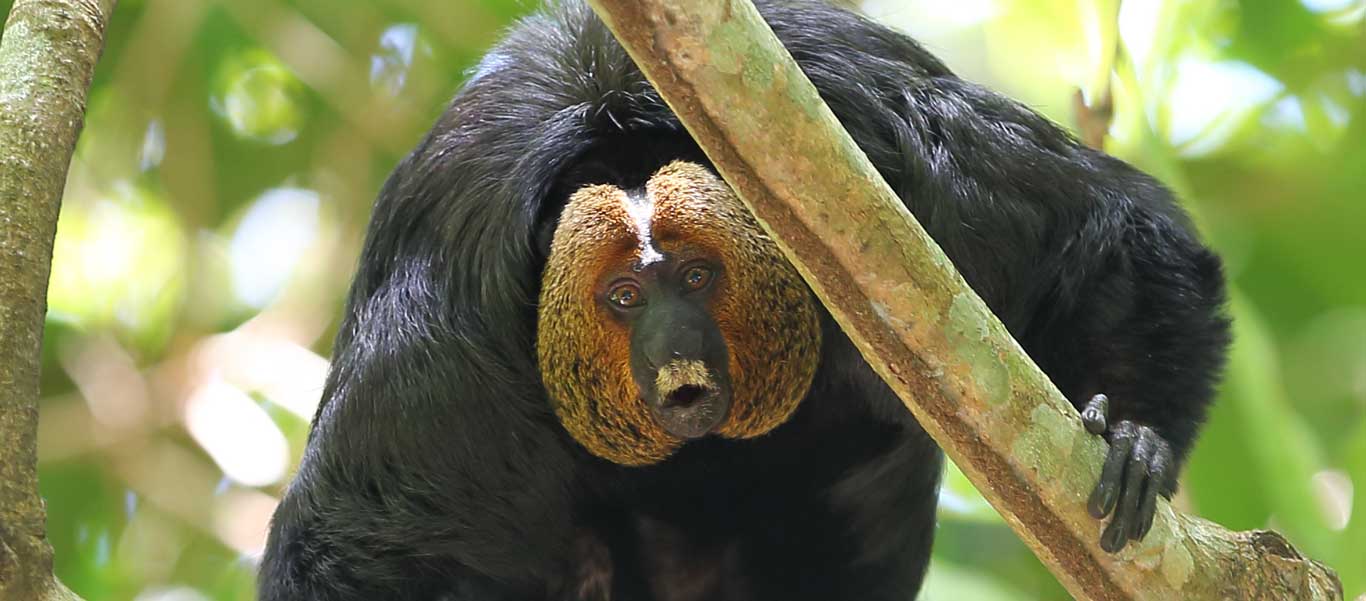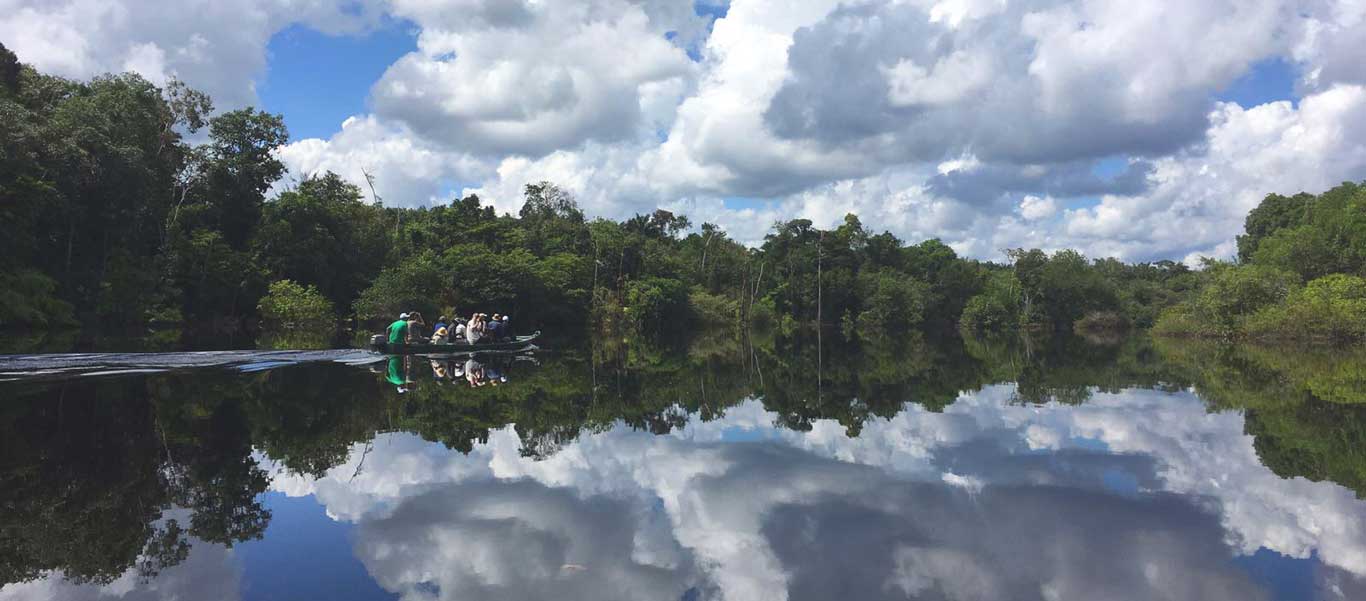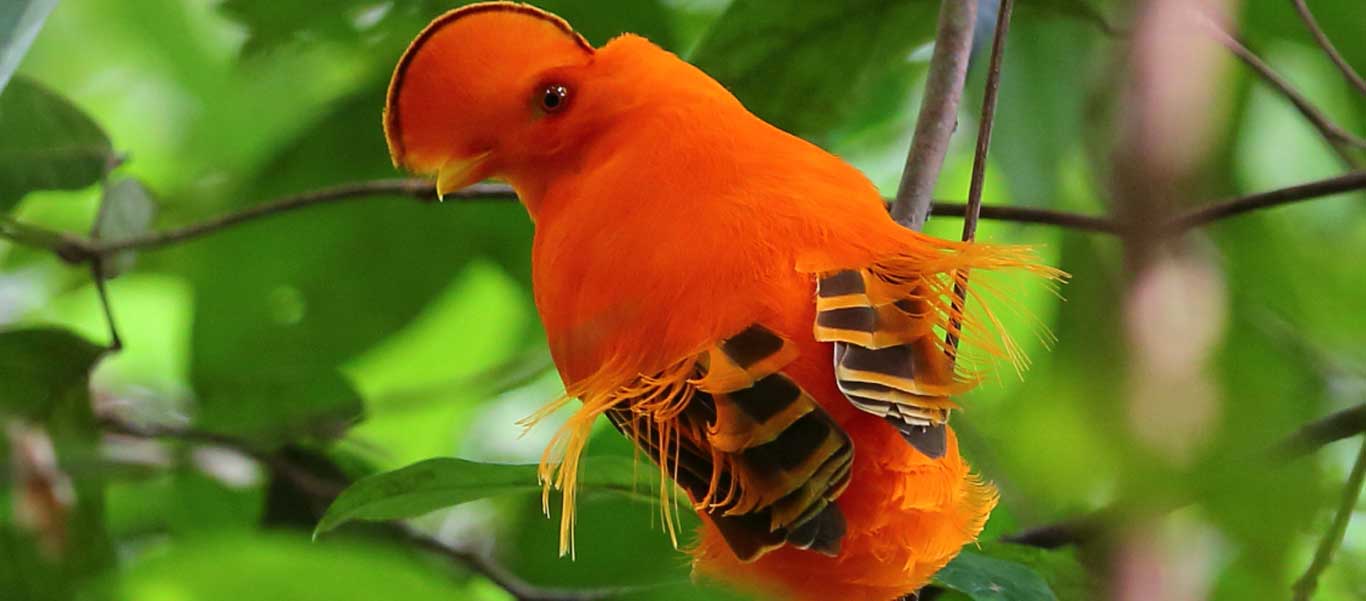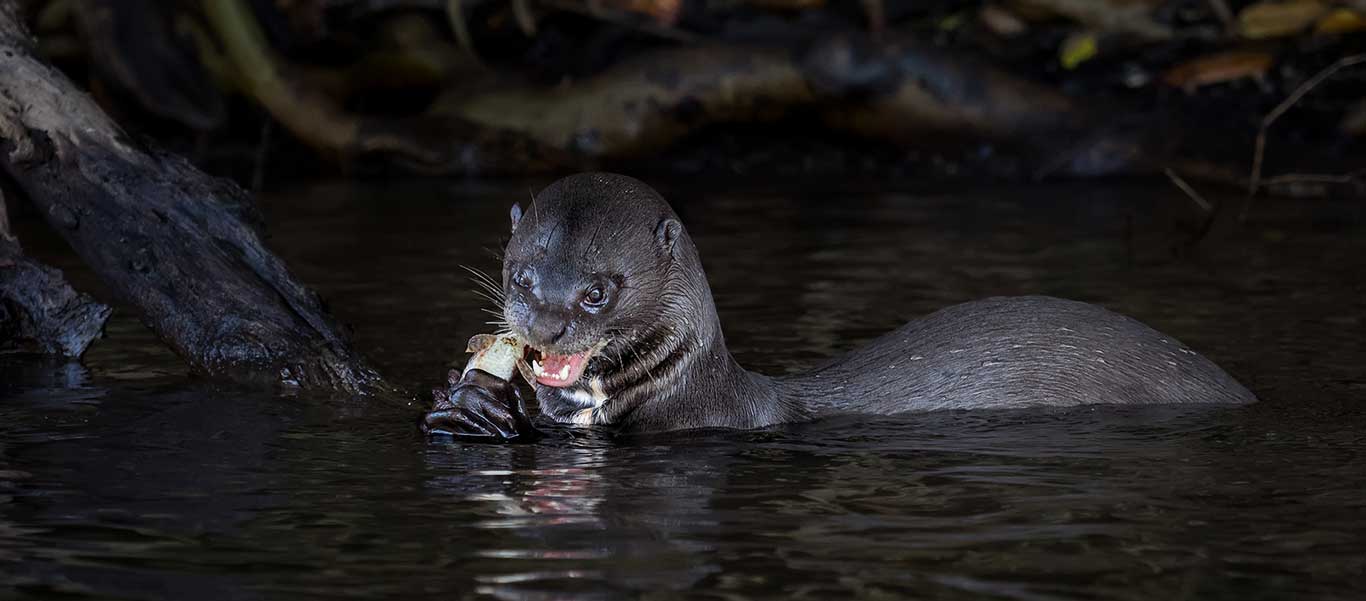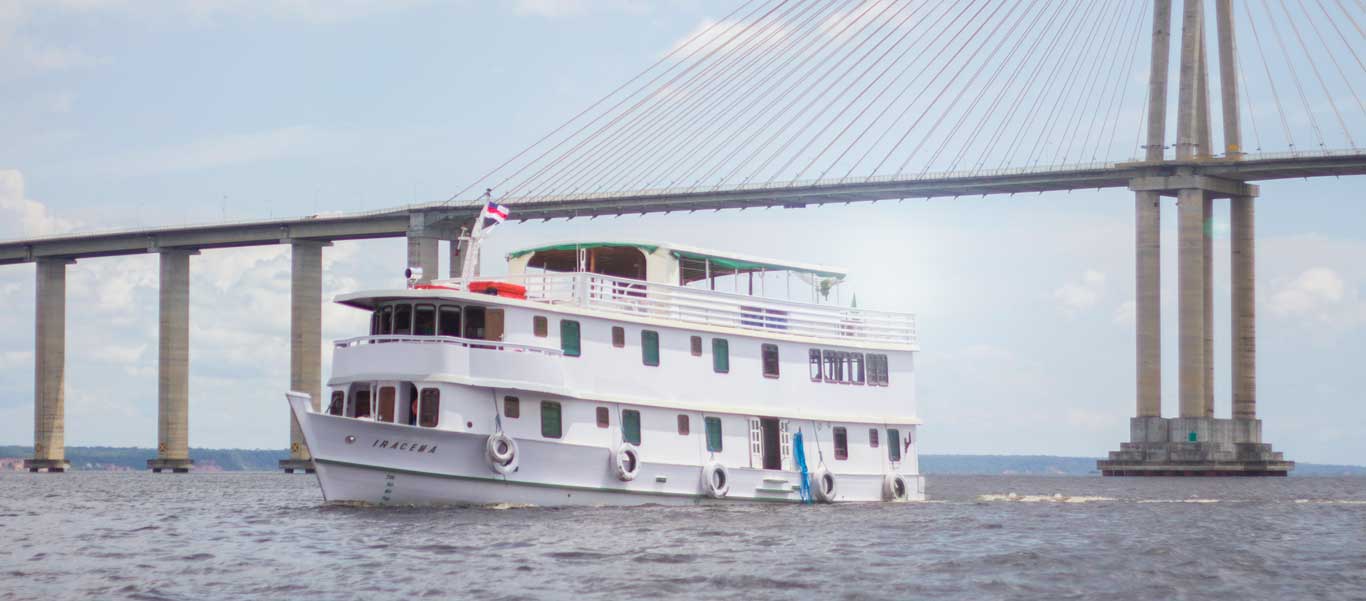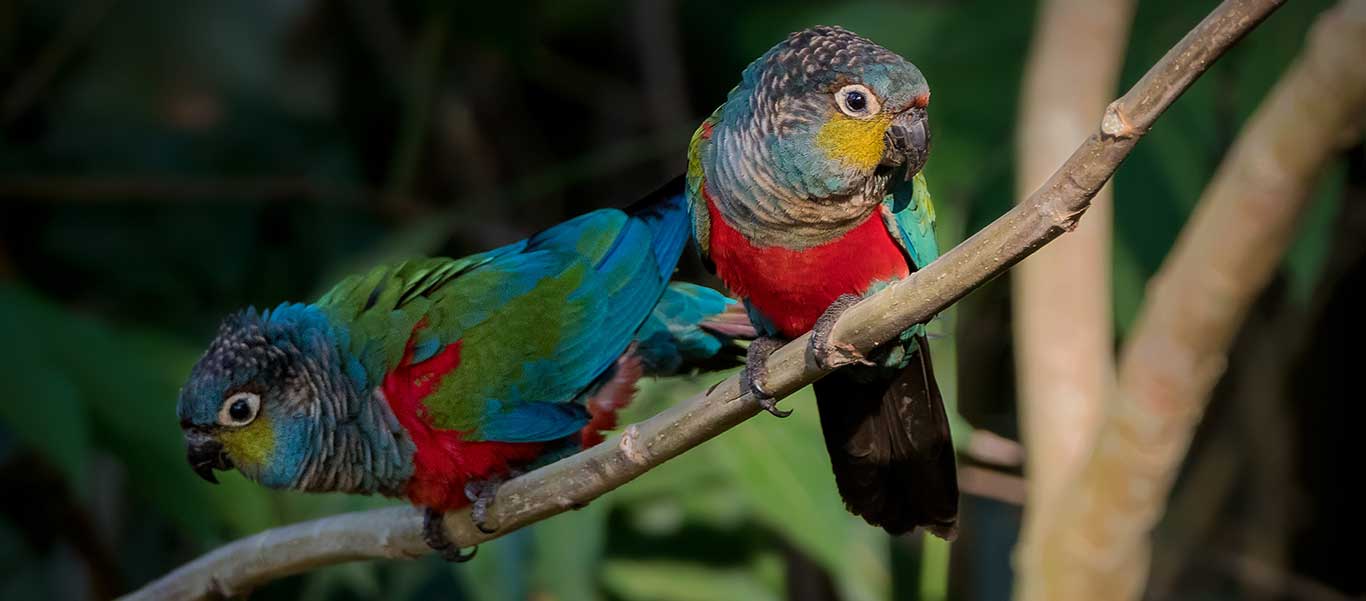Amazonian Brazil
June 14 – 30, 2025
Amazon River Cruise
In the mid-19th century, a young English naturalist, Alfred Russel Wallace, sailed into the delta of the world’s largest river, pushing upstream to seek his fortune in the central Amazon. Little has changed in the region since that time. There are few roads, air access is negligible, and what settlements exist are clustered along the rivers, still the only access routes into this isolated region. The intervening century of biological exploration since Wallace has, however, transformed our appreciation of Brazil’s phenomenal biological riches. It is the world’s most biodiverse country, boasting more animals and plants than any other. Mammal diversity exceeds 500 species with primates alone numbering over 100 species, almost a third of all primate species on Earth. The bird tally runs to a jaw-dropping 1,910 species, while the amphibian and freshwater fish faunas are by far the richest on Earth. Our first expedition in 2018 holds the honor of being the first tourists ever to see the Martin’s Bare-faced Tamarin. Join Apex on an Amazon River cruise and discover some of the rarest, least known, and most sought-after creatures on Earth!
Destinations
- Travel by Air
- Travel by Road
- Travel by Boat
- Travel by Bullet Train
- Travel by Rail
- Travel by Dog Sled
- Day 1
- Day 2
- Day 3
- Days 4 & 5
- Day 6
- Day 7
- Day 8
- Day 9
- Day 10
- Day 11
- Day 12
- Day 13
- Day 14
- Day 15
- Day 16
- Day 17
-
Manaus
Arrive into Manaus late this evening and transfer to your hotel, set on a bluff overlooking the Amazon’s largest tributary, the Rio Negro. Overnight at the Tropical Executive Hotel.
-
Manaus
After a leisurely morning and lunch, kick off your Amazonian experience with an afternoon stroll around the hotel’s sprawling tropical gardens, a haven for wildlife. The strange and beautiful Golden-faced Saki Monkey is resident here but the real prize would be locating a family of Pied Bare-faced Tamarins, an endangered primate with a highly localized range centered on Manaus. Pale-throated Three-toed Sloths are not uncommon, and with perseverance and careful scrutiny of the treetops you may also locate the shaggy, primarily nocturnal Southern Two-toed Sloth. The familiar yelping of White-throated Toucans and liquid notes of displaying Crested Oropendolas are constant background sounds, and mixed flights of parrots and parakeets are commonly seen high over the Rio Negro. Gather this evening for a welcome dinner and formal briefing at the Tropical Executive Hotel.
-
Manaus / Embark the MV Iracema / Praia Grande
Depart early this morning to visit the Museu da Amazônia (MUSA) Canopy Tower, situated in the 40-square-mile Adolfo Ducke Forest Reserve. Watch sunrise from atop the 120-foot tower, with a veritable surround-sound cacophony of birdsong, in the realm of dazzlingly colorful cotingas, toucans, trogons, and tanagers. Large flights of parrots, from Scarlet and Red-bellied Macaws to Caica and Blue-headed Parrots, pass by at eye level, and, with luck, you may even encounter the magnificent Red-fan Parrot. Guianan Red Howler Monkeys are often equally vocal, with other primate possibilities including Pied Bare-faced Tamarin and Bearded Saki, with its bizarre bouffant hairdo. Walking the trails below the tower, watch for Red-rumped Agouti and Guianan Squirrel.
This afternoon, board the MV Iracema, a classic, triple-decker river boat with a shallow draft; comfortable air-conditioned, en suite cabins; and abundant deck space for easy wildlife observation. Meet the experienced captain, Mo Fortes, affectionately known as “Junior”, and his crew, and join the expedition team for drinks on deck as you push out into the Rio Negro and commence sailing.
Be on the lookout for Black Uakari Monkeys. Uakaris are the most active of all New World monkeys, due to a varied diet high in nutritional value, and are highly mobile and tricky to track down, as a result. Searching for these charismatic monkeys is a fitting beginning to an epic voyage, spanning over 1,000 miles, multiple interfluvia, and countless micro-habitats.
-
Rio Negro and Amazon Confluence
Wake this morning to a routine that will become familiar over the coming days, with sunrise coffee on deck to appreciate the sights and sounds of the rainforest coming to life.
After breakfast, experience one of the most extraordinary wildlife encounters on Earth: swimming with Pink Dolphins! Known locally as Boto, these undeniably and indescribably pink, freshwater cetaceans are completely wild, and yet accustomed to the presence of humans, allowing close approach in the tea-colored water of the Rio Negro. Then board the slender boats that are your mode of transportation into these narrow waterways, for your first foray into the flooded forest. The trip has been specifically timed to coincide with the peak of the annual Amazon floods, when high water levels facilitate easier access to remote areas, as well as more intimate viewing of wildlife in the canopy.
The Amazon and its larger tributaries act as formidable barriers to dispersion of animals, essentially dividing the great basin into an archipelago of forested “islands”, each home to their own unique fauna. Over the next two days, explore the complex maze of braided channels and lagoons south-west of Manaus, including both the tongue of land sandwiched between the Rio Negro and the Amazon (or Solimões, as Brazilians call the upper stretches), and the waterlogged country to the south of the Amazon.
The elusive Chestnut-bellied Titi and Gray’s Bald-faced Saki Monkey are your two main target primates in this area, known as the Janauacá River, and are amongst an incredible 30 possible primate species to see during our transect from Manaus to Santarém. No other place on Earth boasts so rich and diverse a primate fauna, and one of the primary objectives of this expedition will be to find, and spend time with, as many of these spectacular creatures as possible. Venezuelan Red Howlers, Humboldt’s Squirrel Monkeys, and White-fronted Capuchin Monkeys are all numerous and regularly encountered here.
-
Laguinho
Travel along the Madeira River—one of the largest tributaries of the Amazon—to the Laguinho area, one of the best places to experience the phenomenon of Amazon river islands. Islands in the main Amazon are constantly shifting, eroding at their upstream edge and depositing on their downstream side, effectively migrating downriver with time. This complex pattern of plant succession creates a spectrum of habitats that appeal to a distinctive suite of unique birds, some of which are never seen off a river island, such as Red-and-white Spinetail, the dapper Black-and-white Antbird, and Varzea Piculet, a minute woodpecker.
-
Madeira River / Nova Olinda
With high floodwaters, the captain prefers to sail along a system of parallel channels to the main Amazon, and today you enter the small channel of Arariá, from the Madeira River. Just as you enter the channel, you’re in prime territory for spotting the monkey known by the local people as “algodão”, meaning cotton, but known to primate biologists as the Golden-white Tassle-eared Marmoset. While exploring the area in canoes, listen for the distinctive morning chorus of the Baptista Lake Titi Monkey, which has one of the smallest distributions of any primate. The flooded forest around Nova Olinda also hosts the jewel-like Crimson-hooded Manakin, which boasts a head as brilliant as sealing wax.
-
Abacaxis River
Today, rise to the challenge of trying to view the Satéré Marmoset, an elusive species restricted to the area between the Madeira and Abacaxis Rivers. Golden-backed Squirrel Monkeys are decidedly more numerous, and birding is excellent in this area, with colorful Red-necked and Chestnut-eared Aracaris, Crimson-crested and Yellow-tufted Woodpeckers, and elegant Paradise Jacamars regularly encountered.
-
Paraconi River
Spend a first morning in the Maués interfluvium, a complex system of lakes and river channels. This is the habitat of yet another rare, little known, and downright glamorous marmoset known as the Maués Marmoset. Our day is expeditionary, as we forge up the Paraconi River. If the opportunity presents itself, set off on short hikes in the late afternoon and into the evening, searching for nocturnal creatures while appreciating the sounds of the night forest.
-
Amanã River
A large tributary of the Maués Açu channel, the Amanã River offers an excellent chance to find the hulking Black Howler Monkey, handsome White-fronted Capuchin and Gray’s Bald-faced Saki.
Sail down the Parauari River in the late afternoon, admiring groups of Hoatzins sunning themselves on streamside vegetation, or carefully scanning the treetops for the rare White-tailed Cotinga, before the bats and Ladder-tailed Nightjars start moving over the water.
-
Campina do Parauari
Dawn will find you high up the Maués River. Higher ground here supports a unique, fairly open and beautiful forest growing on poor soils known locally as “campina”. While exploring this campina, be on the lookout for swarms of army ants, which may be attended by so-called inveterate ant swarm followers, such as Pale-faced Bare-eye and Harlequin Antbird.
In the afternoon, head to high forest on a quest for Golden Parakeet and Bald Parrot and watch the horizon for flocks of these two magnificent and highly endangered psittacines winging to roost. This is among the most pristine forest of your voyage, and you have the possibility of encountering Razor-billed Curassow and White-crested Guan, indicator species of very low hunting pressure.
-
Furo Maçuari
A pre-dawn departure gets you into position to search for the rare Hoffmann’s Titi Monkey. Favoring areas of dense, vine-tangled forest, titis are medium-sized monkeys best located at dawn, when they vocalize vociferously. If fortunate enough to hear a group within striking range, you’ll carefully pick your way through for a view of these shy, reclusive folivores.
Over lunch, relocate to the small Maués-Mirim River, to another area known to support a healthy population of the gorgeous Black and White Tassel-ear Marmosets, also known as the Santarem Marmoset. Nocturnal excursions are an exciting component of any exploration of the Amazon, yielding a completely fresh complement of creatures, from Spectacled Caimans to Rainbow Boas, and Kinkajous to prehensile-tailed Brazilian Porcupines.
-
Mamuru River
This morning, continue your exploration of the south bank in the vicinity of the Mamuru River. To the west of the Tapajos River lies the range of the hulking Black Howler, as well as Black and White Tassel-ear Marmoset. Tamarins and marmosets differ from other New World monkeys by their small size and by possessing claws instead of nails. But it is their habit of routinely giving birth to twins that is most endearing, and the hope is to encounter a family with youngsters as they forage for flowers, fruits and plant sap. In the afternoon, cross the great Amazon to be in position to explore the north bank, where species of Guianan affinity may be found.
-
Lagoa Itapicuru and the Trombetas River
Dawn at Lagoa Itapicuru will find us appreciating one of the Amazon’s most celebrated plants, the Victoria amazonica water lily. Although the giant, three-foot-wide leaves of this nocturnal blooming lily are capable of supporting the weight of a baby, we’re more likely to find noisy Wattled Jacanas trotting across their lily pads, alongside a plethora of other Amazonian waterbirds, from Anhingas and Black-collared Hawks to Amazon and Ringed Kingfishers.
After breakfast, use the Iracema as a mobile observation tower, motoring slowly along the forested edges of the Trombetas River, a tributary that penetrates remote territory on the north bank of the Amazon. Scan the treetops for movement and listen carefully for the telltale calls that may reveal the presence of Martin’s Bare-face Tamarins, a rare and localized primate scarcely seen by any Western primatologist until your indomitable captain located a population here.
-
Ventilado, on the Trombetas River
Visit Ventilado, a village far up the Trombetas River. The settlement traces its roots to refugees from Brazilian sugar plantation slavery in the early 1800s. Meet with some of its inhabitants and discover their way of life, with fishing and subsistence farming traditions remaining unchanged for centuries.
Trails behind the village offer access to tall terra firme forest growing on white sand, an extension of the Guianan forests. Spend the morning searching for groups of Golden-handed Tamarin, a primate endemic to the Guianan center of endemism, along with an array of Guianan avian endemics, from puffbirds to cotingas and woodcreepers to antbirds. In the afternoon, climb to the dancing arena of the Guianan Cock-of-the-Rock, a brilliant orange cotinga whose display ranks as one of the most spectacular bird displays on Earth. Later, head downstream, and cross the Amazon to the south side, once again.
-
Alter do Chão
Wake at Alter do Chão, an area of clear, fresh water and sandbars in the Tapajos River. For your primate finale, the forest east of the Tapajos River is home to the impressive Spix’s Red-handed Howler and the diminutive Silvery Marmoset. Although the primates are the principal focus, you will also be looking for such rare and localized birds as White-crested Guan and the glorious Golden Parakeet. This evening, toast the end of a successful voyage in Lago Maripá, as the first fishing bats emerge to skim the waters, then enjoy a festive farewell dinner.
-
Santarém / Disembark
This morning, sail into Santarém, a bustling river port some 500 miles upstream of the Atlantic Ocean, at the confluence of the Amazon and Tapajos Rivers. Bid farewell to Mo and the rest of the crew of the Iracema and transfer to the airport for your flights homeward.
Details
- June 14 – 30, 2025
- Leaders Diogo Lucatelli & Gerald Broddelez
- $12,970 Per Person Rate
- $20,760 Solo Rate
- 17 days Trip Length
- 16 guests
- Manaus Start
- Santarém End
Call us to reserve your spot on this exciting expedition!

